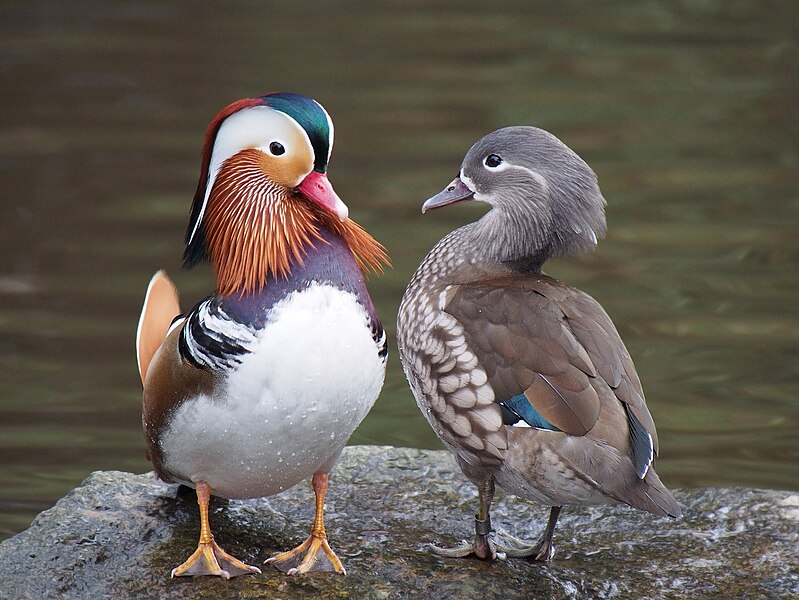Mandarin Duck Bird Details
Aix galericulata
Mandarin Duck,Chinese Duck, Mandarin Teal;
Mandarin Batak
Giovanni Antonio Scopoli (1777)
Anseriformes (DUCKS)
Anatidae
Aix
- China, Japan, North Korea, and Russia, Western Europe and North America.
- India(Himachal Pradesh and Uttarakhand)
Appearance :
The male Mandarin Duck is known for its extravagant plumage, featuring a combination of bright colors, including orange "sails" on the back, a greenish head, and a white stripe across the face. Females are more subdued in color, with a brownish-grey body and white eye rings.
Behaviour :
Mandarin Ducks are known for their shy and timid nature. They are primarily dabbler ducks and can often be seen swimming or foraging for food near the water's edge.
Habitat :
They prefer forest lakes, ponds, and slow-moving rivers with plenty of overhanging vegetation for cover.
Diet :
Their diet consists mainly of aquatic plants, seeds, fruits, and small invertebrates.
Conservation Status :
Least Concern
Distribution :
Native to East Asia, particularly China, Japan, and Korea. Some populations migrate to Southeast Asia during the winter months.
Population Size :
The global population is estimated to be in the tens of thousands
Life Span :
In the wild, Mandarin Ducks can live up to 10 years.
Body And Tarsus:
- Body: The Mandarin Duck has a medium-sized, compact body with an overall length of about 40-50 cm. Males are particularly noted for their vibrant colors and elaborate plumage.
- Tarsus Length: Approximately 4 to 5 cm.
Head And Bill :
- Head: The male has a distinctive, rounded head with a striking green color, while females have a more subdued brown coloration with white eye rings.
- Bill: The bill is relatively short, broad, and flat.
- Bill Length: About 2.5 to 3.5 cm long.
Length :
Typically measures around 40 to 50 cm in length.
Neck :
The neck is short and thick, seamlessly blending into the body, giving the duck a compact appearance.
Size :
Males are typically larger and more colorful than females, making them stand out in the water.
Tail Details :
- Tail: The tail is long and pointed, with distinctive feather extensions in males that are characteristic of the species.
- Tail Length: Approximately 8 to 10 cm long.
- Feathers: Males exhibit a colorful plumage with a mix of orange, green, and white. Females have a more subdued brown and grey coloration.
Weight :
ypically weighs between 500 to 1,000 grams.
Wing :
The wings are broad and pointed, which allows for quick and agile flying.
Wing Span :
The wingspan ranges from 70 to 80 cm.
Facial Feature :
Males have a distinctive greenish head with a white stripe running down the face, while females have a more muted coloration with brown tones.
Nest Details :
- Nest: Mandarin Ducks build their nests in tree cavities, dense vegetation, or on the ground near water bodies.
- Nest made up of: Nests are constructed using leaves, grasses, and feathers, often lined with soft down feathers for insulation.
Breeding Season :
The breeding period typically occurs from April to June.
Nesting Season :
Nesting season usually falls within the spring months, primarily in April and May.
Egg Color :
The eggs are typically pale cream or white in color.
Egg Length :
Approximately 4.5 to 5.5 cm long.
Egg Width and Weight :
- Egg Width: About 3.5 to 4 cm wide.
- Egg Weight: Each egg weighs around 30 to 50 grams.
Clutch Size :
Clutch sizes generally range from 6 to 12 eggs.
No. of Broods :
Usually, they raise one brood per season.
Incubation Period :
The incubation period lasts about 28 to 30 days.
Nestling Period :
The ducklings are precocial and leave the nest shortly after hatching, relying on their parents for protection and food for about 8 to 10 weeks.
Vocalization :
Vocalizations include soft whistles and quacks.
Sex Demorphism :
es, there is significant sexual dimorphism. Males are brightly colored and have elaborate plumage, while females are more subdued in color, primarily brown and grey.
Migration Details :
- Migration Pattern: Mandarin Ducks are primarily resident in their breeding areas but may migrate short distances in search of better habitats during winter.
- Migration Period: Migration occurs primarily during the autumn and spring months, depending on environmental conditions and food availability.
- Migration Route: They do not have a fixed migration route, as most populations remain in their breeding areas year-round, though some may move south to Southeast Asia in winter.
Explore More Birds Of Same Genus
No birds of same genus found

